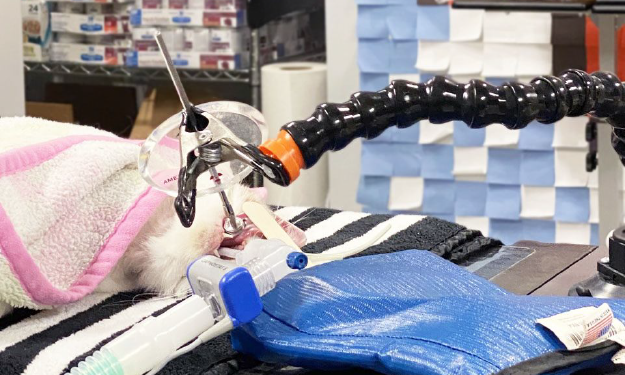Plesiotherapy: A Non-Invasive Treatment for Tumors in Pets

Plesiotherapy involves the use of a radioactive probe to apply large single doses of radiation to superficial tumors. These probes were first developed to treat ocular lesions in people, but they have been found to be useful in treating a number of tumors in dogs and cats.
The Sr-90 applicator is a specialized instrument that can safely deliver high doses of radiation to small/superficial tumors. The radiation that comes from Sr-90 does not penetrate beyond several mm below the skin surface. This allows the entire radiation dose to usually be given in a single treatment without affecting the deeper tissues with only mild local side effects. Most patients treated with Strontium-90 radiation develop mild irritation in the area which forms a crust that heals over 4-6 weeks. These side effects rarely bother the pet.
Our radiation oncology team has extensive experience with Strontium-90 therapy. Our own Dr. Gordon is a co-author of the largest series of cats treated with this modality.1 In this study, 98% of cats had a successful response to treatment for an average of over 4 years!
A board-certified radiation oncologist should assess any candidate before treatment to determine whether the treatment is appropriate and to calculate the radiation dose.
Some examples of tumors that are commonly treated with Strontium-90 include:
- Eyelid tumors in dogs, cats, and other species
- Ear tip tumors in dogs and cats, and other species
- Superficial carcinomas of the nasal plane in cats
- Feline mast cell tumors
- Carcinomas of the uropygial gland in birds
- Other superficial/small tumors that are not believed to penetrate more than a few millimeters deep
Strontium radiation does require that patients be anesthetized to ensure the safety of the pet and staff but typically the procedure is less than 10-15 minutes to deliver the entire dose.
1. Evaluation of strontium Sr 90 for the treatment of superficial squamous cell carcinoma of the nasal planum in cats: 49 cases (1990-2006) JAVMA 2007, 231 (5):736-41